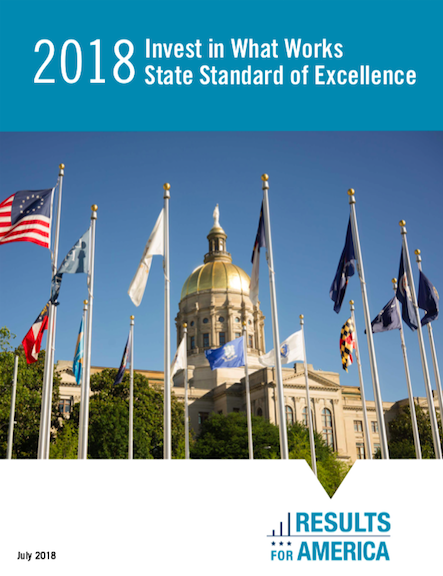Twenty-two new governors are taking office.¹ From the moment they are sworn in, all of them will be faced with a cascade of important choices. They will be required to balance budgets and do what is best for their state’s residents while trying to fulfill their campaign proposals and focus on long-term goals. Data and evidence can be their most valuable tools in implementing their agendas.
Governors can pave the way for efficient systems and better outcomes for their constituents if they champion the use of data-driven and evidence-based practices and policies. In Massachusetts, for example, Governor Charlie Baker’s (R) administration was able to link vast data sets to coordinate solutions for the state’s opioid epidemic, helping overdose rates decline last year for the first time this decade. And under Governor Jerry Brown’s (D) leadership, the California Franchise Tax Board used data to improve operations, generating $3.7 billion in revenues. Now it is possible for new governors to fulfill their campaign pledges and get results by adapting data-driven programmatic models that have been successful in other states. Models exist in areas ranging from government transparency and operational efficiency to schools and social services.
In Kansas, Governor-elect Laura Kelly (D) pledged to improve the transparency of state government. New governors with similar objectives can get a head start by looking to the efforts that Governor Bill Haslam has undertaken in Tennessee over the last eight years. Transparent TN is the state’s data and performance website which includes dashboards with specific sub-goals, targets, and performance data in numerous areas as well as fiscal data related to agencies’ programmatic spending. Applying this model can help governors increase accountability. As Governor-Elect Kelly put it, “We must change the culture of closure in Topeka and that starts at the top with the governor. State government — from our prisons to our healthcare facilities to our foster care system — needs to be held accountable to the people.”
In Illinois, Governor-elect J.B. Pritzker (D) focused his campaign on improving the state’s social services safety net for its most vulnerable residents “by properly funding effective evidence-based programs like home visitation for at-risk youth, community-based mental health, and violence prevention.” Oregon provides a good model: a 2003 law requires youth, health, and criminal justice agencies to “spend at least 75 percent of state moneys that the agency receives for programs on evidence-based programs,” perform cost-benefit analyses, and compile a program inventory with results from funded programs. New governors interested in using proven programs might also look to Florida where the Department of Juvenile Justice developed the Sourcebook of Delinquency Interventions, which lists all juvenile justice programs according to their level of evidence (from evidence-based practices and promising practices to practices with demonstrated effectiveness).
Improving education was another important theme in races across the country this year as numerous gubernatorial candidates focused on how to increase opportunity and prepare students for good jobs. In California, Governor-elect Gavin Newsom (D) campaigned on the importance of unleashing educational data to “connect our early childhood, K-12 and higher education data systems so that we can best serve California’s students as they progress through their education.” Similarly in Connecticut, Governor-elect Ned Lamont (D) proposed to evaluate the state’s investment in job training programs “based on longitudinal data available from the income tax and unemployment insurance records, [and] steer students to enroll in successful programs.”
As new administrations get underway, governors could look to data-sharing models that have already been implemented in other states, including Texas and Kentucky. The Texas Student Data System collects, manages, shares, and reports state education data at all levels. This allows the system to provide visibility into important information such as college readiness trends. Connecticut could use the model of Kentucky’s Center for Education and Workforce Statistics, which collects and links high-quality, actionable data from five state agencies to improve education and workforce programs in the state. This data allows the state to track key metrics such as outcomes for career and technical training as well as kindergarten readiness and college completion.

All of the exemplary practices described above, and nearly 80 more, are featured in the 2018 Invest in What Works Standard of Excellence, released in July 2018 at an event co-hosted by Results for America and the National Governors Association. By following this road map and building on the successes of their predecessors across the country, new governors can effectively use data and evidence in budget, policy, and management decisions to achieve better outcomes for their residents — and fulfill their campaign promises, too.
¹ These 22 new governors include 20 states and 2 territories.
Jed Herrmann is Senior Policy Advisor at Results for America. Alexandra Cawthorne Gaines is Program Director for Human Services at the National Governors Association Center for Best Practices.
Results for America offers free technical assistance to state governments to help them improve their use of evidence and data to get better results. Results for America is holding briefings with governors and their staff about strategies for using data and evidence to improve results. To request a free briefing please contact [email protected].
The NGA Center for Best Practices teams and divisions develop innovative solutions to today’s most pressing public policy challenges. The center is the only research and development firm that directly serves the nation’s governors.